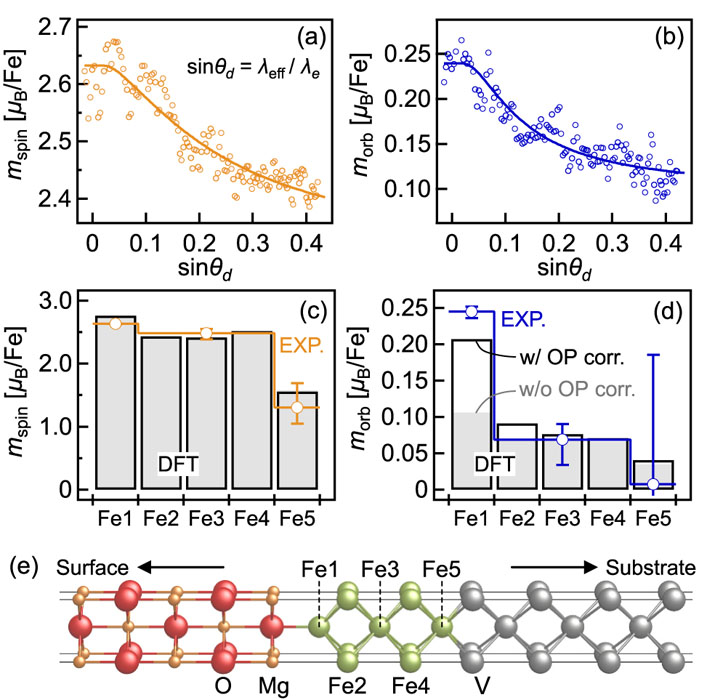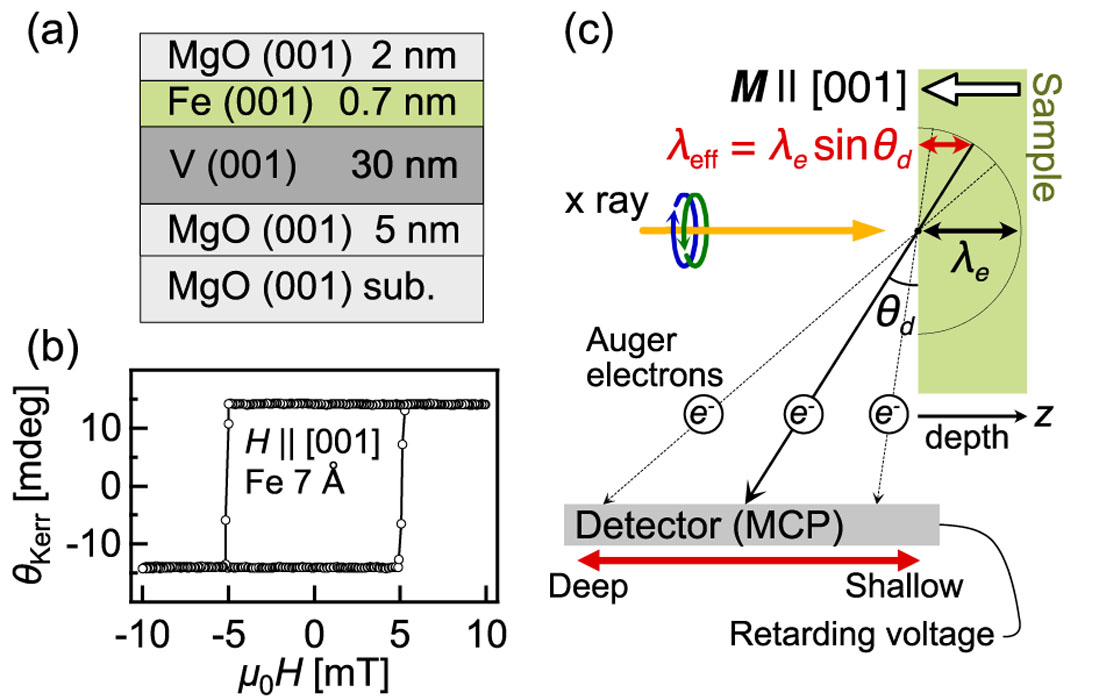Electron-Correlation-Driven Enhancement of Orbital Polarization at the Fe/MgO Interface
Miwa Group
Utilizing electron spins in electronic devices is a central theme in the field of spintronics. The giant tunneling magnetoresistance (TMR) effect and interfacial perpendicular magnetic anisotropy (PMA) in Fe/MgO-based multilayer systems are the foundation of such spintronics applications. For both effects, the atoms located at the interface play crucial roles. That is, the interfacial spin and orbital polarization determines TMR and PMA, respectively. Therefore, it is essential to understand how Fe atoms behave at the interface with MgO by characterizing their spin and orbital magnetic moments to further improve TMR and PMA.
For such a purpose, we performed depth-resolved x-ray magnetic circular dichroism (XMCD) measurements on the V/Fe/MgO trilayer grown on an MgO(001) substrate (Fig. 1(a)) The trilayer showed PMA, as confirmed by magneto-optical Kerr effect measurements with out-of-plane magnetic fields (Fig. 1(b)). The principle of the depth-resolved XMCD [1] is shown in Fig. 1(c). Here, photoelectrons emitted at different angles were detected separately. Because electrons have a finite inelastic mean free path λe in solids, the probability of inelastic electrons at depth z escaping into the vacuum depends on the electron emission angle θd. Therefore, detecting electrons as a function of θd yields probing depth (λeff) dependent XMCD spectra and hence the depth profiles of the spin and orbital magnetic moments. The depth-resolved XMCD measurements were conducted at the beamline BL-7A at the Photon Factory.
The obtained spin and orbital magnetic moments were plotted against the detection angles in Figs. 2(a) and 2(b), respectively. Both the spin and orbital magnetic moments increased as the detection angles decreased, suggesting that they enhanced near the Fe/MgO interface. By performing curve fitting, we estimated the magnetic moment of each layer, as shown by the solid staircase-like lines in Figs. 2(c) and 2(d). The obtained depth profiles show interfacial enhancement of the Fe orbital and spin magnetic moments at the Fe/MgO interface. By contrast, the spin magnetic moment diminished at the Fe/V interface.

Fig. 2. Detection-angle-dependent (a) spin magnetic moment mspin, (b) orbital magnetic moment morb. Solid curves represent the fit. Depth profiles of (c) spin magnetic moment and (d) orbital magnetic moment. Staircase-like lines with open markers represent experimental data; black bars and gray shaded bars represent results of first-principles calculations with and without orbital polarization (OP) correction, respectively. (e) Supercell used for calculations.
To interpret the experimental observations, we performed first-principles calculations. Figure 2(e) shows the used supercell. The calculated magnetic moments are shown by the gray shaded bars in Figs. 2(c) and 2(d). Although the calculations reproduced interfacial enhancement of the spin magnetic moments, it significantly underestimated the orbital counterpart. To resolve this discrepancy, we performed the calculations with orbital polarization (OP) correction. This correction accounts for the electron–electron correlation by satisfying Hund’s second rule and provide an accurate description of orbital magnetic moments and PMA. The OP correction calculations considerably increased the orbital magnetic moment at the Fe/MgO interface close to the experimental value, as shown by the black bars in Figs. 2(c) and 2(d). This agreement suggests that the electron–electron correlation, probably strengthened by interfacial electron localization, enhance the orbital magnetic moment at the Fe/MgO interface and the PMA.
The present findings [2] should also apply to other ferromagnetic metal/oxide interfaces, including CoFeB/MgO systems, as enhanced electron−electron correlation is generic to such interfaces with the abrupt termination of metallic bonds. Furthermore, this study provides insights into the importance of considering electron−electron correlation, which have often been disregarded in spintronics, to understand various phenomena that emerge at interfaces.
References
- [1] K. Amemiya, Phys. Chem. Chem. Phys. 14, 10477 (2012).
- [2] S. Sakamoto, M. Tsujikawa, M. Shirai, K. Amemiya, and S. Miwa, ACS Appl. Electron. Mater. 4, 1794 (2022).

